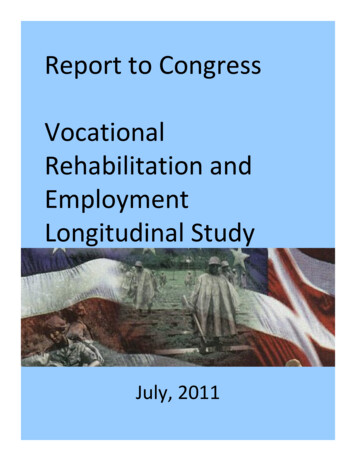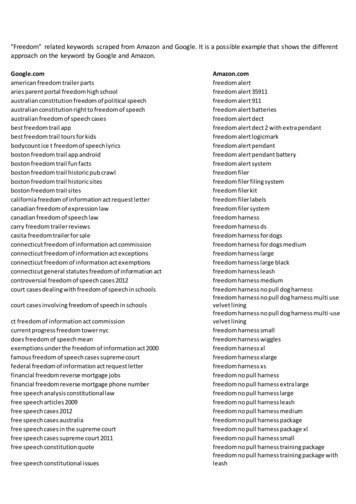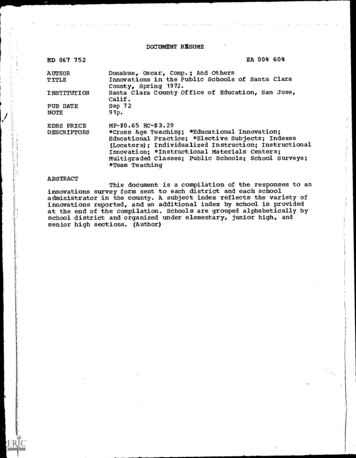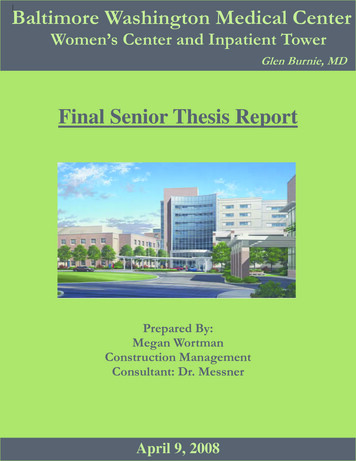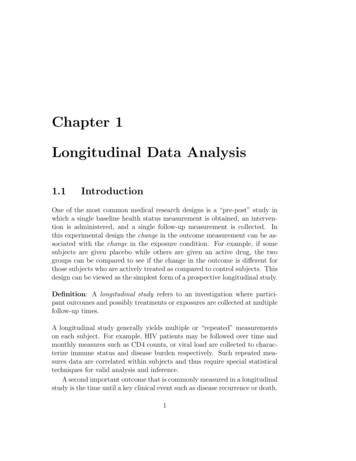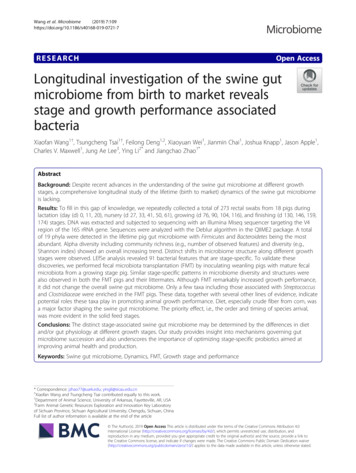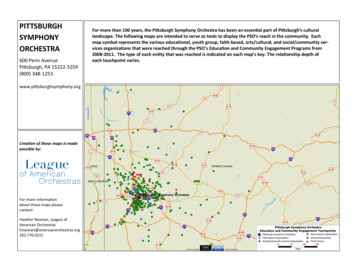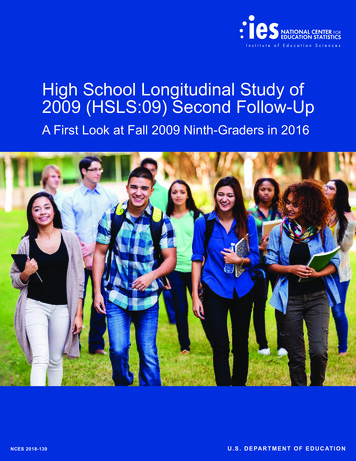
Transcription
High School Longitudinal Study of2009 (HSLS:09) Second Follow-UpA First Look at Fall 2009 Ninth-Graders in 2016NCES 2018-139U . S . D E PA R T M E N T O F E D U C AT I O N
This page intentionally left blank
High School Longitudinal Studyof 2009 (HSLS:09) SecondFollow-Up:A First Look at Fall 2009 Ninth-Graders in 2016February 2018Alexandria Walton RadfordLaura Burns FritchKatherine LeuMichael DupreyRTI InternationalElise M. ChristopherProject OfficerNational Center for Education StatisticsNCES 2018-139U.S. DEPARTMENT OF EDUCATION
U.S. Department of EducationBetsy DeVosSecretaryInstitute of Education SciencesThomas W. BrockCommissioner for Education ResearchDelegated the Duties of DirectorNational Center for Education StatisticsPeggy CarrActing CommissionerSample Surveys DivisionChris ChapmanAssociate CommissionerThe National Center for Education Statistics (NCES) is the primary federal entity for collecting, analyzing, and reporting data relatedto education in the United States and other nations. It fulfills a congressional mandate to collect, collate, analyze, and report full andcomplete statistics on the condition of education in the United States; conduct and publish reports and specialized analyses of themeaning and significance of such statistics; assist state and local education agencies in improving their statistical systems; and reviewand report on education activities in foreign countries.NCES activities are designed to address high-priority education data needs; provide consistent, reliable, complete, and accurateindicators of education status and trends; and report timely, useful, and high-quality data to the U.S. Department of Education, theCongress, the states, and other education policymakers, practitioners, data users, and the general public.We strive to make our products available in a variety of formats and in language that is appropriate to a variety of audiences. You, asour customer, are the best judge of our success in communicating information effectively. If you have any comments or suggestionsabout this or any other NCES product or report, we would like to hear from you. Please direct your comments toNCES, IES, U.S. Department of EducationPotomac Center Plaza (PCP)550 12th Street, SWWashington, DC 20202February 2018The NCES Home Page address is https://nces.ed.gov.The NCES Web Publications and Products address is https://nces.ed.gov/pubsearch.This report was prepared for the National Center for Education Statistics under Contract No. ED-IES-14-C-0112 with RTIInternational. Mention of trade names, commercial products, or organizations does not imply endorsement by the U.S. Government.Suggested CitationRadford, A.W., Fritch, L.B., Leu, K., and Duprey, M. (2018). High School Longitudinal Study of 2009 (HSLS:09) Second Follow-Up: A FirstLook at Fall 2009 Ninth-Graders in 2016 (NCES 2018-139). U.S. Department of Education. Washington, DC: National Center forEducation Statistics. Retrieved [date] from https://nces.ed.gov/pubsearch.This publication is only available online. To download, view, and print the report as a PDF file, go to the NCES Publications andProducts address shown above.Content ContactElise M. Christopher(202) 245-7098elise.christopher@ed.gov
iiiAcknowledgmentsThe authors would like to thank the fall 2009 ninth-graders who have participated inthe multiple data collections for this study. We would also like to thank the parents,teachers, principals, and counselors who completed surveys in prior rounds of thisstudy and school staff who supplied high school transcripts and information onschool course offerings. This study would not have been possible without theirparticipation. Finally, we wish to acknowledge the contribution of the HSLS:09Technical Review Panels to the design of the study and its instruments.
This page intentionally left blank
vContentsPAGEAcknowledgments . iiiList of Tables . viiList of Figures . xiIntroduction . 1Focus of this Report . 1Study Design . 2Selected Findings . 5Figure and Tables . 7References . 23Appendix A—Estimates and Standard Errors for Figure 1 andStandard Errors for Tables 1–13 . A-1Appendix B—Analysis Variables . B-1Appendix C—Technical Notes and Methodology. C-1
This page intentionally left blank
viiList of TablesTABLEPAGE1.Percentage distribution of fall 2009 ninth-graders’ high schoolcompletion status as of February 2016, by student and high schoolcharacteristics: 2016. 82.Percentage distribution of fall 2009 ninth-graders’ enrollment inpostsecondary education as of February 2016, and among those who hadnot enrolled, percentage reporting various reasons for not enrolling, bystudent and high school characteristics: 2016 . 103.Percentage distribution of fall 2009 ninth-graders’ postsecondaryenrollment and labor force participation status in February 2016, bystudent and high school characteristics: 2016 . 114.Among fall 2009 ninth-graders who never enrolled in postsecondaryeducation but were employed in February 2016, median hours worked,percentage distribution of self-assessment of relationship betweenFebruary job and job they expected to have at age 30, and percentagewhose 2015 income was 10,000 or less, by student and high schoolcharacteristics: 2016. 125.Among fall 2009 ninth-graders who never enrolled in postsecondaryeducation, percentage who had been unemployed for at least 1 monthbetween leaving high school and February 2016, and among those,percentage who had received unemployment compensation, mediannumber of months of longest unemployment spell, and median numberof unemployment spells of 1 month or more, by student and high schoolcharacteristics: 2016. 136.Among fall 2009 ninth-graders who never enrolled in postsecondaryeducation, percentage who reported experiencing various financialcircumstances during 2015, by student and high school characteristics:2016 . 147.Percentage of fall 2009 ninth-graders who never enrolled inpostsecondary education reporting that their parents regularly helpedcover various needs in 2015, by student and high school characteristics:2016 . 15
viiiLIST OF TABLESTABLEPAGE8.Percentage of fall 2009 ninth-graders who had enrolled in postsecondaryeducation, and among them, percentage distribution of the number ofmonths between completing or leaving high school and first enteringpostsecondary education, by student and high school characteristics:2016 . 169.Among fall 2009 ninth-graders who had enrolled in postsecondaryeducation, percentage distribution of control and level of institution inwhich they first enrolled after high school, by student and high schoolcharacteristics: 2016. 1710.Among fall 2009 ninth-graders who had enrolled in an undergraduatedegree or certificate program between completing or leaving high schooland February 2016, percentage distribution of major field of study intheir most recent undergraduate degree or certificate program, by studentand high school characteristics: 2016. 1811.Among fall 2009 ninth-graders who ever enrolled in postsecondaryeducation, percentage distribution of attainment and retention at firstinstitution as of February 2016, by student and high schoolcharacteristics: 2016. 2012.Among fall 2009 ninth-graders who ever enrolled in postsecondaryeducation, percentage distribution of attainment and persistence at anyinstitution as of February 2016, by student and high schoolcharacteristics: 2016. 2113.Among fall 2009 ninth-graders who ever enrolled in postsecondaryeducation, percentage who had not attained a postsecondary credentialand were no longer enrolled as of February 2016, and among these,percentage reporting various reasons for not being enrolled, by studentand high school characteristics: 2016. 22A-1.Standard errors for table 1: Percentage distribution of fall 2009 ninthgraders’ high school completion status as of February 2016, by studentand high school characteristics: 2016. A-2A-2.Standard errors for table 2: Percentage distribution of fall 2009 ninthgraders’ enrollment in postsecondary education as of February 2016, andamong those who had not enrolled, percentage reporting various reasonsfor not enrolling, by student and high school characteristics: 2016 . A-3A-3.Standard errors for table 3: Percentage distribution of fall 2009 ninthgraders’ postsecondary enrollment and labor force participation status inFebruary 2016, by student and high school characteristics: 2016 . A-4
LIST OF TABLESTABLEPAGEA-4.Standard errors for table 4: Among fall 2009 ninth-graders who neverenrolled in postsecondary education but were employed inFebruary 2016, median hours worked, percentage distribution of selfassessment of relationship between February job and job they expectedto have at age 30, and percentage whose 2015 income was 10,000 orless, by student and high school characteristics 2016 . A-5A-5.Standard errors for table 5: Among fall 2009 ninth-graders who neverenrolled in postsecondary education, percentage who had beenunemployed for at least 1 month between leaving high school andFebruary 2016, and among those, percentage who had receivedunemployment compensation, median number of months of longestunemployment spell, and median number of unemployment spells of1 month or more, by student and high school characteristics: 2016 . A-6A-6.Standard errors for table 6: Among fall 2009 ninth-graders who neverenrolled in postsecondary education, percentage who reportedexperiencing various financial circumstances during 2015, by student andhigh school characteristics: 2016 . A-7A-7.Standard errors for table 7: Percentage of fall 2009 ninth-graders whonever enrolled in postsecondary education reporting that their parentsregularly helped cover various needs in 2015, by student and high schoolcharacteristics: 2016. A-8A-8.Standard errors for table 8: Percentage of fall 2009 ninth-graders whohad enrolled in postsecondary education, and among them, percentagedistribution of the number of months between completing or leavinghigh school and first entering postsecondary education, by student andhigh school characteristics: 2016 . A-9A-9.Standard errors for table 9: Among fall 2009 ninth-graders who hadenrolled in postsecondary education, percentage distribution of controland level of institution in which they first enrolled after high school, bystudent and high school characteristics: 2016 . A-10A-10. Standard errors for table 10: Among fall 2009 ninth-graders who hadenrolled in an undergraduate degree or certificate program betweencompleting or leaving high school and February 2016, percentagedistribution of major field of study in their most recent undergraduatedegree or certificate program, by student and high school characteristics:2016 . A-11ix
xLIST OF TABLESTABLEPAGEA-11. Standard errors for table 11: Among fall 2009 ninth-graders who everenrolled in postsecondary education, percentage distribution ofattainment and retention at first institution as of February 2016, bystudent and high school characteristics: 2016 . A-13A-12. Standard errors for table 12: Among fall 2009 ninth-graders who everenrolled in postsecondary education, percentage distribution ofattainment and persistence at any institution as of February 2016, bystudent and high school characteristics: 2016 . A-14A-13. Standard errors for table 13: Among fall 2009 ninth-graders who everenrolled in postsecondary education, percentage who had not attained apostsecondary credential and were no longer enrolled as of February2016, and among these, percentage reporting various reasons for notbeing enrolled, by student and high school characteristics: 2016 . A-15A-14. Estimates for figure 1: Percentage distribution of fall 2009 ninth-graders’postsecondary enrollment and labor force participation status in February2016, by high school completion, postsecondary enrollment, andpostsecondary attainment status: 2016 . A-16A-15. Standard errors for table A-14 and figure 1: Percentage distribution of fall2009 ninth-graders’ postsecondary enrollment and labor forceparticipation status in February 2016, by high school completion,postsecondary enrollment, and postsecondary attainment status: 2016 . A-17C-1.Summary of HSLS:09 response rates by data collection round andinstrument . C-6C-2.Summary statistics for unit nonresponse bias analyses before and afterweight adjustments for nonresponse, by HSLS:09 second follow-up andsupplemental 2013 update analytic weights . C-8
xiList of FiguresFIGURE1.PAGEPercentage distribution of fall 2009 ninth-graders’ postsecondaryenrollment and labor force participation status in February 2016, by highschool completion, postsecondary enrollment, and postsecondaryattainment status: 2016 . 9
This page intentionally left blank
1IntroductionFocus of this ReportThis report presents selected findings from the second follow-up of the High SchoolLongitudinal Study of 2009 (HSLS:09). HSLS:09 follows a nationally representativesample of students who were ninth-graders in fall 2009 from the beginning of highschool into higher education and the workforce. Key research topics for HSLS:09include secondary to postsecondary transition plans and the evolution of those plans;paths into and out of science, technology, engineering, and mathematics (STEM)studies and careers; and the relationships between students’ school experiences(educational and social) and their academic, work, and life plans and paths.The second follow-up data collection was conducted from March 14, 2016, throughJanuary 31, 2017, approximately 3 years after high school graduation for most of thecohort. The data collected allow researchers to examine an array of young-adulthoodoutcomes among fall 2009 ninth-graders, including delayed high school completion,postsecondary enrollment, early postsecondary persistence and attainment, labormarket experiences, family formation, and family financial support. Analyses of theseoutcomes can capitalize on the large amounts of data gathered about the students infall 2009, in 2012 (when most were spring-term 11th-graders), and in summer andfall 2013 (when most had completed high school). Analyses can also be augmentedwith information collected from parents, teachers, administrators, counselors, andhigh school transcripts.This report highlights selected findings from the HSLS:09 second follow-up datawith the goal of encouraging interested researchers to explore the data for their ownanalytic purposes. Therefore, the report provides information on a range ofoutcomes, although HSLS:09 offers much more data than those used in the analysesin this report. Readers should note that, because this report is descriptive in nature, itis not appropriate to draw causal inferences from the results presented. For example,many of the variables examined in this report may be related to one another, andcomplex interactions and relationships among the variables have not been exploredin these analyses.All results have been weighted to reflect the sample design and to account fornonresponse and other adjustments. Comparisons drawn in the selected findingshave been tested for statistical significance at the .05 level using Student’s t statisticsto ensure that the differences are larger than those that might be expected due to
2INTRODUCTIONsampling variation. While the selected findings only include statistically significantfindings, they do not include every statistically significant comparison. There were noadjustments for multiple comparisons. Detail may not sum to totals because ofrounding.Additional information about the HSLS:09 dataset and the methods employed incollecting and processing the data can be found in appendix C, and greater detail isavailable in the HSLS:09 Base-Year to Second Follow-Up Data File Documentation (Dupreyet al. 2018), at https://nces.ed.gov/surveys/hsls09/.Study DesignHSLS:09 is a longitudinal study of a nationally representative sample ofapproximately 20,000 ninth-graders. HSLS:09 used a two-stage sample design. First,high schools, defined as schools with both a ninth and an eleventh grade in fall 2009,were sampled, and then students were sampled from each school’s ninth grade in thefall term. The sampled schools consist of private and public schools, includingcharter and magnet schools, that provided instruction in the 50 states and District ofColumbia. More information about the sample design, including classification ofineligible cases, is available in appendix C.The HSLS:09 dataset contains data, collected from several sources, on students andtheir school and home environments. The base-year data collection featured a studentsurvey and mathematics assessment as well as surveys completed by schooladministrators, school counselors, science teachers, mathematics teachers, and parentsof the sampled students. The first follow-up of HSLS:09 occurred in spring 2012,when most sample members were in the 11th grade, and included a student survey andmathematics assessment, as well as surveys completed by school administrators,school counselors, and parents of the sampled students. The 2013 Update datacollection was a brief, between-round status update consisting of a short survey to becompleted by either the sample member or the sample member’s parent. It occurredin summer and fall 2013 and captured information on sample members’ high schoolcompletion status and employment or postsecondary education plans. Transcript datawere also collected in 2013 and 2014 from all high schools where sample memberswere known to have attended.The second follow-up survey of HSLS:09 was conducted between March 2016 andJanuary 2017, about 3 years after most sample members had graduated from highschool, and is highlighted in this First Look. Although most of the estimates in thisFirst Look were generated from student survey data, the report does includeestimates that incorporate data collected in prior rounds from parents and highschool transcripts.
INTRODUCTIONThe number and timing of future follow-ups are yet to be determined; however,HSLS:09 is also collecting students’ postsecondary financial aid records andtranscripts in 2017. A First Look report and data from the collection of students’postsecondary financial aid records and transcripts are scheduled for release in 2019.3
This page intentionally left blank
5Selected FindingsAmong all fall 2009 ninth-graders by February 2016, Ninety-two percent of all fall 2009 ninth-graders had earned a high school diploma byFebruary 2016; of those who scored in the lowest fifth on the 2012 HSLS mathematicsachievement test, however, 81 percent had earned a diploma, compared with 99 percent ofthose who scored in the highest fifth (table 1). Four percent of all fall 2009 ninth-graders had not earned any type of high school credentialby February 2016. Among these, 67 percent were employed, 20 percent were unemployed(not working but looking for work), and 13 percent were not in the labor force (not workingand not looking for work) (figure 1). Seventy-two percent of all fall 2009 ninth-graders had enrolled in postsecondary educationbetween completing or leaving high school and February 2016 (table 2). When nonenrolleeswere asked to select one or more reasons why they had not enrolled, 9 percent choseacademic reasons, 42 percent reported financial reasons, 43 percent indicated personal orfamily reasons, 32 percent chose work reasons, and 14 percent chose none of these. In February 2016, some 7 percent of all fall 2009 ninth-graders were enrolled inpostsecondary education and employed full time, 26 percent were enrolled in postsecondaryeducation and employed part time, 5 percent were enrolled in postsecondary education andunemployed, and 13 percent were enrolled in postsecondary education but not in the laborforce (table 3). Another 25 percent were not enrolled in postsecondary education but wereemployed full time, 11 percent were not enrolled in postsecondary education but wereemployed part time, 8 percent were not enrolled in postsecondary education and unemployed,and 6 percent were not enrolled in postsecondary education and not in the labor force.Among fall 2009 ninth-graders who had not enrolled in postsecondaryeducation after high school by February 2016, The median number of hours worked per week by fall 2009 ninth-graders who had notenrolled in postsecondary education after high school but were employed in February 2016was 40 (table 4). When asked whether their current job was related to the job they expected tohave at age 30, about one-quarter (23 percent) felt that their job was closely related, 8 percentfelt that their job was somewhat related, and 25 percent felt that their job was not at all relatedto the job they expected to have at age 30. The remaining 43 percent did not know or did notplan to work at age 30. Thirty-nine percent of fall 2009 ninth-graders who had not enrolled in postsecondaryeducation after high school but were employed in February 2016 had an income of 10,000 orless in 2015 (table 4). Fifty-two percent of fall 2009 ninth-graders who had not enrolled in postsecondary educationafter high school had been unemployed for at least 1 month between leaving high school andFebruary 2016 (table 5). Among these, the median length of their longest unemployment spellwas 5 months, and the median number of unemployment spells they experienced was two.
6SELECTED FINDINGS During 2015, three-fifths of fall 2009 ninth-graders who had not enrolled in postsecondaryeducation after high school had worried about having enough money for regular expenses likefood, clothing, housing, and transportation (table 6). Twenty-six percent of fall 2009 ninth-graders who had not enrolled in postsecondaryeducation after high school regularly received help from parents for rent, room and board, ormortgage payments in 2015, and 26 percent regularly received help from parents for healthcare costs in 2015 (table 7). Nineteen percent regularly received help from parents withmonthly bills, utilities, car payments, or credit card bills.Among fall 2009 ninth-graders who had enrolled in postsecondary educationafter high school by February 2016, Eighty-two percent of fall 2009 ninth-graders who had enrolled in postsecondary educationbetween high school and February 2016 enrolled within 4 months of leaving high school(table 8). Among those who enrolled, Asians had enrolled within 4 months at a higher ratethan Blacks and Hispanics had (91 percent compared with 78 percent and 76 percent,respectively). Thirty-six percent of fall 2009 ninth-graders who had enrolled in postsecondary educationafter high school first enrolled at a public 2-year college, 41 percent at a public 4-year college,and 16 percent at a private nonprofit 4-year college (table 9). The remainder (7 percent)attended a for-profit or other type of institution. Fall 2009 ninth-graders who had enrolled in a postsecondary degree or certificate programafter high school pursued a variety of fields of study. For example, when asked what fieldsthey studied in the postsecondary education program in which they had most recentlyenrolled, 17 percent first listed a health field, 14 percent first listed business, and 20 percentfirst listed any of a number of other applied fields (e.g., personal and consumer services;manufacturing, construction, repair, and transportation; military technology and protectiveservices, architecture; communications; public administration and human services; design andapplied arts; law and legal studies; library sciences; and theology and religious vocations)(table 10). Among fall 2009 ninth-graders who had enrolled in postsecondary education after highschool, 5 percent had earned an undergraduate certificate and 5 percent had earned anassociate’s degree as their highest credential attained at the first institution in which theyenrolled as of February 2016 (table 11). Regardless of institution (i.e., first or other), 6 percenthad earned an undergraduate certificate and 6 percent had earned an associate’s degree astheir highest credential (table 12). Twenty-two percent of fall 2009 ninth-graders who had enrolled in postsecondary educationafter high school had not attained a postsecondary credential and were not enrolled as ofFebruary 2016 (table 13). When asked to select one or more reasons for leaving withoutearning a credential, 24 percent chose academic reasons, 40 percent picked financial reasons,48 percent selected personal or family reasons, 22 percent chose work reasons, and 9 percentchose none of these.
7Figure and Tables
8FIGURE AND TABLESTable 1.Percentage distribution of fall 2009 ninth-graders’ high school completion status as ofFebruary 2016, by student and high school characteristics: 2016High schooldiplomaHigh schoolequivalency¹No high school diplomaor 25.1Race/ethnicity2WhiteBlackHispanicAsianOther or Two or more ��4.7Highest education attained by either parentHigh school credential or lower3Certificate or associate’s degreeBachelor’s degree or higher88.291.795.95.64.22.46.24.21.8Mathematics achievement quintileLowest fifthMiddle three-fifthsHighest fifth81.492.299.47.44.40.511.23.4‡Cumulative high school grade point averageLess than 2.502.50–2.993.00–3.493.50 or higher81.897.699.099.68.61.2 !0.8 !0.4 !9.51.2‡‡Control of high schools attendedOnly publicOnly privateBoth public and private91.199.596.04.4‡2.6 !4.5‡1.5 !CharacteristicTotal! Interpret data with caution. Estimate is unstable because the standard error is more than 30 percent but no greater than 50 percent of theestimate.‡ Reporting standards are not met either because the standard error was greater than 50 percent or there were too few cases for a reliableestimate.1 Includes certificates of attendance or completion.2 Black includes African American, Hispanic includes Latino, and Other or Two or more races includes American Indian or Alaska Native,Pacific Islander or Native Hawaiian, and respondents having origins in more than one race. Race categories exclude Hispanic origin unlessspecified.3 Includes high school diplomas, high school equivalencies, and certificates of attendance or completion.NOTE: Detail may not sum to totals because of rounding.SOURCE: U.S. Department of Education, Institute of Education Sciences, National Center for Education Statistics, High School LongitudinalStudy of 2009 (HSLS:09), Second Follow-Up.
FIGURE AND TABLES9Figure 1. Percentage distribution of fall 2009 ninth-graders’ postsecondary enrollment and l
Alexandria Walton Radford . Laura Burns Fritch . Katherine Leu . Michael Duprey . RTI International . Elise M. Christopher . Project Officer . . percentage who had received unemployment compensation\, median number of months of longest unemployment spell, and median number of unemployment spells of 1 month or more, by student and high school .
